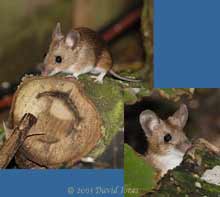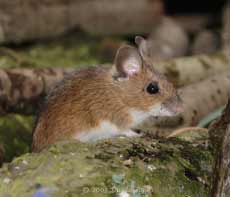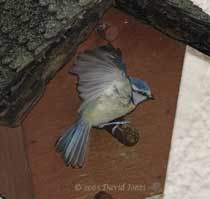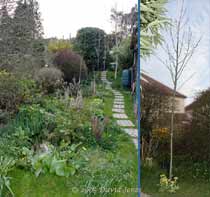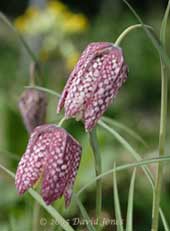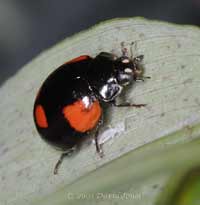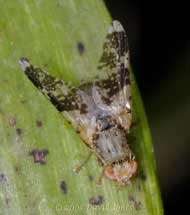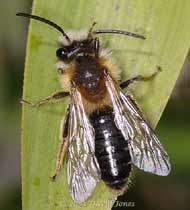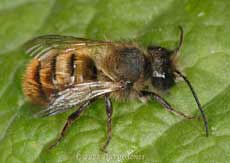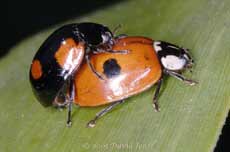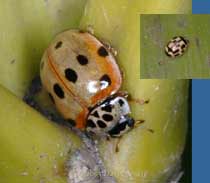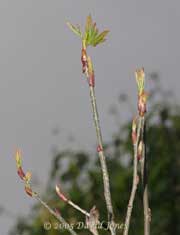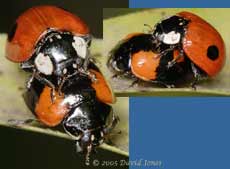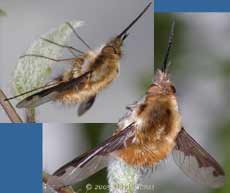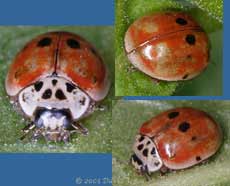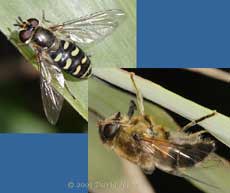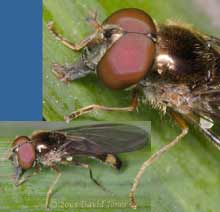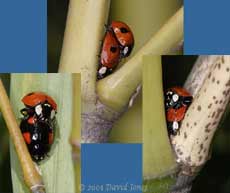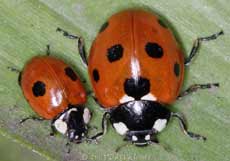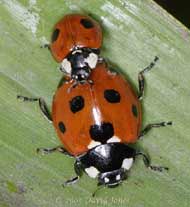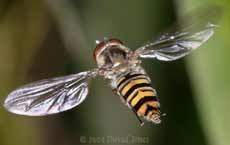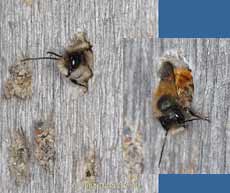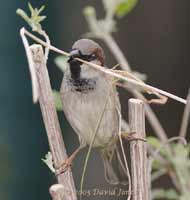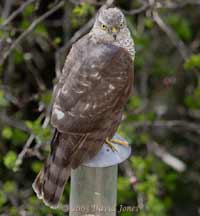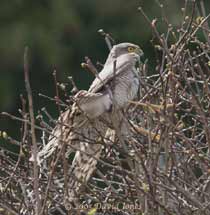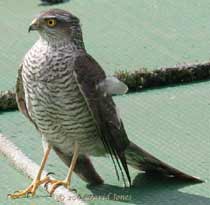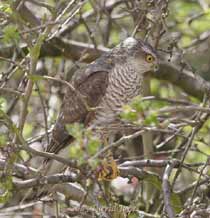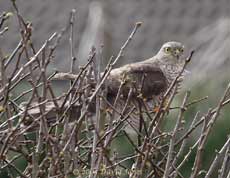Go to latest entry of the month ......Go to previous entry1 April - A dry day with broken cloud. I planted the Rowan today, between the big pond and the Birch tree, and tonight I feel as though I've planted a forest! Perhaps tomorrow will need to be another day off...
Although I cannot be sure what species it is, I think it matches best the descriptions I have found of a Wood Mouse.
You'll have to forgive me for including another picture of it as it paused on top of a log.
In the meantime, a Blue Tit took numerous pieces of straw from the bundle I've stuffed into the branches of the Buddleia plant, and then flew off West over the conifers. The female Blackbird also has us wondering. She was tearing out moss from the bank of the big pond this morning. Sheila thinks that it flew into the Ivy tree. We shall have to watch for more activity tomorrow.
2 April - A Sunny, and quite warm day - very pleasant, with very little done. There was time to sit, drink coffee and watch! First of all, I managed to see that the Blackbird was in fact building her nest in the conifers beyond the end of my neighbour's garden. Was is the operative word, as a short time later I could only watch helplessly as another neighbour's cat tried to catch her as she arrived with more materials. The Blackbird escaped but that was the end of that nest. Later in the morning she was collecting grass once again, and this time she was definitely taking it into our Ivy tree. I have my fingers crossed that she will be successful this time - I shall be watching for progress, and the neighbour's cat, which already knows that it isn't welcome here.
It's amazing how quickly the garden is turning more green now as most of the plants thrive. In the left hand picture you can just make out the Rowan tree against the backround of the Ivy. The right hand image shows it from the other direction. I saw a bird perch on it for the first time this morning - a Blue Tit!
Next to the big pond the first of the Snakes Head Fritillary flowers opened today, and by coincidence, I added another 'bunch' (bought yesterday) to the group this morning.
While we were having coffee down the West Wing three butterflies passed through the garden - a Brimstone, a Holly Blue, and a Comma, which landed right next to me but left again as soon as I moved. As usual on a sunny day there were other visitors to the West Wing , or at least to the bamboos. The 2 and 7-spot ladybirds were there in equal numbers (six each), as well as the Pine Ladybird and the Dock Bug. However, two more species of ladybird made their first appearances of the year.
The second individual is a bit more problematic. Similar at first glance to the Pine Ladybird, it is larger, has two small white spots on the head and has a plain black pronotum (the plate behind the head). My first thought is that it is a 2-Spot ladybird variant known as the quadrimaculata melanic.
After some time drying off in the sunshine on a Cowslip plant, it flew off with no problem. I think it may be a Osmia rufa, and its long antennae suggest it is a male.
3 April - Another very pleasant, sunny day, although a constant breeze prevented it from getting very warm. That was a blessing in a way, as I spent most of the day at the front of the house with son Simon doing a grand job of strengthening our front wall - put up when the house was new in 1937 and getting a bit wobbly now! I now have the task of re-pointing the brickwork over the next couple of weeks (a bit at a time). While we were busy at the front of the house, the Blackbird was hard at work on her nest in the Ivy. Nearly every time I went down the garden to get a tool or something, she was on the ground with some moss or twigs in her beak and I would have to wait until she went to the nest.
Just one picture today, in the way of a confirmation as to the identity of the black bodied ladybird photographed yesterday. It seems that it is a 2-spot Ladybird, and a male one at that!
4 April - This morning it is dull, cool and damp, with light rain at times. In a way I am thankful for that after yesterday's work, but at least the wall is safer!
I need to add just two pictures from yesterday. First, a clearer image of the Adalia 10-punctuata. Second, an unforgivably blurry image (top right) of another small ladybird that flew off as soon as I touched the bamboo plant it was on. I think that one is a 14-spot Ladybird (Propylea 14-punctata).
The first of our Bluebells is now in flower, albeit with white flowers. The first bloom may have opened yesterday when we were otherwise occupied. This is eleven days earlier than last year. Most of the flower buds have still got a bit of developing to do before they open.
5 April - A fine, mainly cloudy day, breezy and cooler than of late (the weather forecast has even suggested the possibility of the sight of snow by the end of the week!). I've only been out in the garden a couple of times today and although the lower temperature obviously reduced insect activity, there was still a surprise waiting for me.
Perched on a bud of a clematis plant and with its underside facing the weak sunshine, it is one of the bee-flies, Bombylius major. Despite its impressive forward pointing proboscis it is harmless. Its larvae attack the underground grubs of solitary bees and wasps.
On a Solanum plant (which grows up the fence at the end of the garden (West Wing) there was this small, solitary ladybird. About 4mm in length it is similar to the ladybird pictured at the beginning of yesterday's report, except that this one has no spots at the rear of the carapace. Also, this has a pronounced white lower edge.
I have forgot to mention the increasing numbers of hoverflies that have been appearing over the last week. The first to appear were the Droneflies (bottom-right image), and then in the last few days there have been several smaller types, such as the smaller Syrphus species (top-left).
7 April - A day of sunshine disrupted by squally April showers, and not as cold as I thought it would be (daytime temperatures have been reaching around 12C over the last few days).
When there is a breeze the ladybirds often shelter in the nodes of the bamboo, where two of these pairs have chosen to mate.
Then, the 2-spot decided to try and mate with the 7-spot! It spent several minutes trying climb onto the slippery carapace and adjusting its position. It seems that the poor 2-spot is a frustrated male that is unable to count spots!!
While watching this pair a hoverfly spent time hovering about me. One of the challenges I've set myself with the new camera is to get a really clear image of a hoverfly in flight. This was my first try, just before I had to retreat from a shower. The image has been cropped quite a bit, but it has captured the abdomen with reasonable sharpness, so there's hope for success before the end of the summer. It is about 12mm in length and the abdominal markings identify it as a Episyrphus balteatus, very common everywhere.
I've already noted the activity of several solitary bees in the garden over the last couple of weeks, but today I have seen solitary bees at the bee hotel for the first time this year. The frequent showers meant that I could only grab a few pictures for the record. I think it is an Osmia species (similar to the one I photographed on a Cowslip a few days ago. If it is Osmia rufa then the white white hairs on the face indicate that it is a male.
8 April - A cloudy day, with strong a Northerly breeze that has stopped the temperature rising much above 5C. There has only been a little bit of rain, and that included just a few snowflakes (the forecasters got it correct!).
Neither did I capture what I saw the Goldfinches doing. They are here a great deal of the time now, usually up to four, but this morning a fifth joined them. (I need to buy a bigger feeder!). Anyway, when two of them finished feeding, they flew down to a Lavender plant and a minute or so later flew off with beaks full of leaves. I set up my camera in case they repeated the behaviour, but since then there have only been visits to feed.
This afternoon I had to rescue my camera from that set-up when this female Sparrowhawk arrived - it's the first time for ages that we have seen one in the garden. This one was determined to catch one of the dozen or so Sparrows that were in the Hawthorn, and her attacks continued for nearly ten minutes.
She adopts a couple of strategies in her attacks. First of all, while the sparrows panic in the upper branches she flies tight orbits of the tree before crashing into it. These two disappointingly blurred pictures show her just before landing on separate attacks.
The high speed landings are not graceful affairs as her wings tangle with the branches, but it is sometimes enough to cause a Sparrow or two to flee out of the other side. This happened on one of her attempts and then Sparrows and hawk disappeared at high speed up the street. However, she was back almost straight away, having missed them.
The first picture, and this one show her as she paused, away from the tree, as though she was taking time to rethink her strategy before another attack.
Her second, perhaps more desperate tactic was to clamber into the tree so that the Sparrows would retreat to the far side. She would then get out quickly to fly around before they could move again.
I can't help interpreting the look on her face as one of frustration and annoyance. I wonder whether her determined efforts are a sign that she has already got offspring to feed?
Click on images to see larger versions |
|
